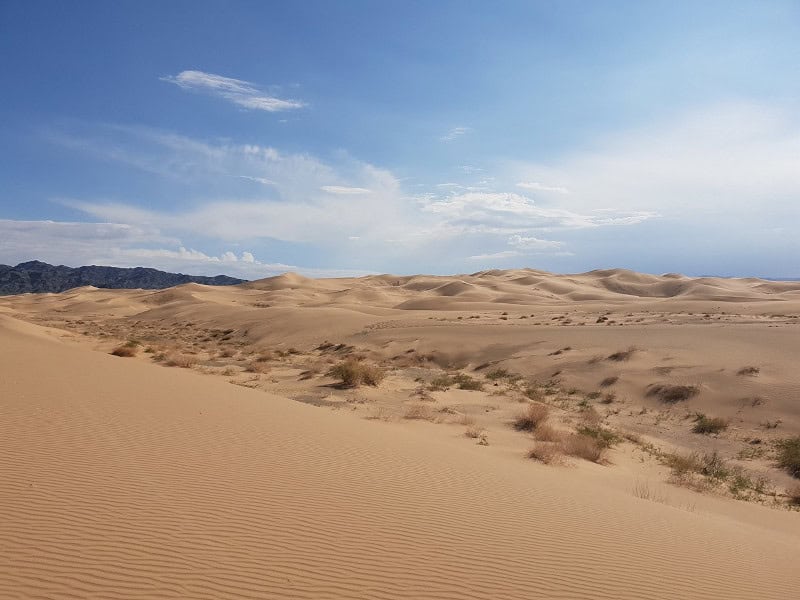
Gobi Desert Facts
- The short term of Gobi Desert serves as the english language name for this starkly beautiful creation of natural forces. It does have other names it’s known by, though. In Chinese, it’s also known by two separate terms, those of sha-mo and han-hal.
- Regardless of which of these terms one chooses to use, it stands out for several reasons. This geological marvel ranks as the sixth-largest desert on the face of the earth. It further distinguishes itself because it’s relatively cold, rather than hot like others.
- Local Indigenous Peoples, of course, long knew of and utilized this marvel of Nature. These included various nomadic tribes wandering the overall region. The great majority of its occupancy, however, was accomplished by Mongols, Kazakhs, and Uyghurs.
- Outsiders knew little of the Gobi Desert until more modern times, though. Numerous individuals, however, contributed to the knowledge of the formation over time. The first known European visitor was the French missionary, Jean-François Gerbillon.
- Today, however, it ranks as an important site for many scientists. The first confirmed dinosaur eggs ever found were discovered here, in 1923. Other treasures found here include prehistoric stone tools, some of which date back more than 100,000 years.
Related Articles
Gobi Desert Physical Description
Despite not being the larget desert in the world, the remarkable Gobi Desert nevertheless captures the imagination. That’s because it still boasts some highly respectable measurements. It also posseses some other attributes that distinguish it from most deserts.
It shape is irregular, of course, as most such features are. In general, though, the site has an elongated, somewhat rectangular pattern to it. In length, it measures approximately 1,000 mi (1,600 km). Its width, on the other hand, equals a maximum of about 500 mi (800 km).
Obviously, however, the exact dimensions of the desert vary across its length and breadth. These dimensions nonetheless provide it with an astounding total area. This specific aspect of the marvel of geology equals roughly 500,000 sq mi (1,295,000 sq km) in total.
Yet, the Gobi Desert stands out from similar features in a unique manner. That’s because a large percentage of its greater area isn’t sand, but exposed, bare rock. It’s additionally surrounded in many places by numerous mountain ranges, including the Tibetan Plateau.
But perhaps its most distinctive characteristic pertains to its surprising climate. That’s true since it’s actually a cold desert. Frost commonly forms on its sand dunes. On occasion, even snow appears there! Winter temperatures often reach as low as – 40C (-40F).
Gobi Desert Location, Expansion, and Ecology
The starkly beautiful Gobi Desert formed in a region of the globe well known for its many marvels, including geological. The precise location, though, might surprise some people. That’s because this arid wonder lies in a portion of the continent of Asia.
Part of its boundaries falls within the confines of the country of Mongolia. There, it lies in the approximate southern portion of the country. The other section of the desert resides inside the borders of the country of China. That section sits in the northwestern region.
Intriguingly, this remarkable site continues to expand its borders at an impressive rate. This ongoing process bears the appropriate term of desertification. The greater portion of this process, however, is occuring along the southern edge of the beautiful formation.
In that region alone, an extraordinary quantity of grassland is being taken over every year. On average, the desert claims roughly 1,390 sq mi (3,600 sq km) annually. Amazingly, though, much of this happens due to human activities, primarily increasing deforestation.
Despite all these harsh conditions, the Gobi Desert contains a moderately thriving ecosystem. The majority of flora in the region consists of several species of shrubs adapted to the conditions. A few types of short grasses also appear in the region, such as needle grass.
Due to the presence of the flora, a surprising number of animal species also live there. This includes at least 30 species of lizards. Others include several mammals unique to the area, such as marbled polecats, black-tailed gazelles, wolves, and even a variety of bear.
Features Sharing Its Region
Check out our other articles on 3 Surprising Sahara Desrt Sites, Ribbon Seal, Great Barrier Reef, Eastern Cicada Killer, Philippine sailfin lizard, Rosy Veincap, Texas Blind Salamander
